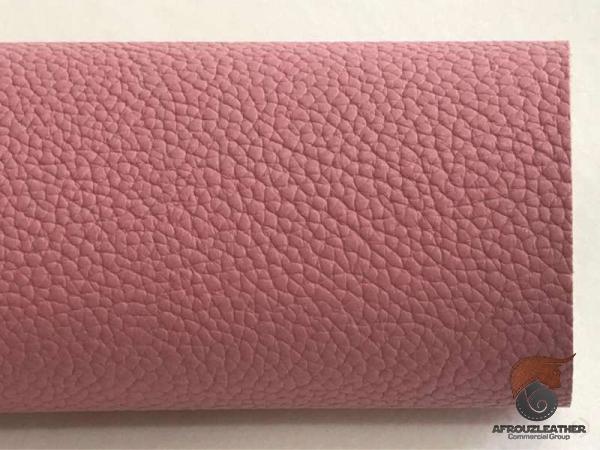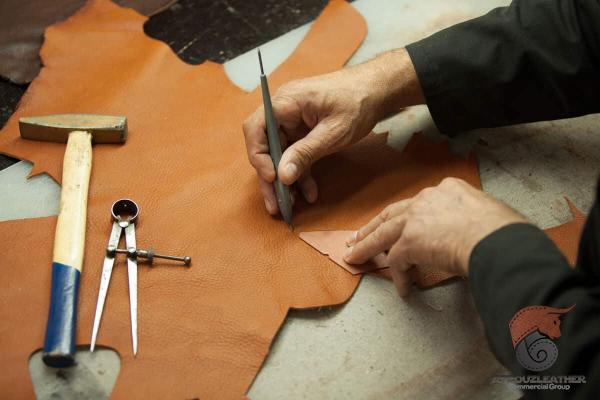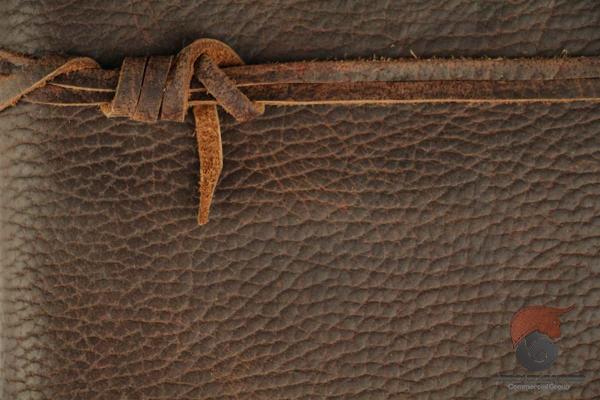Leather has been used for centuries as a durable and stylish material for various applications, ranging from fashion to furniture. However, even within the realm of leather, there are different types and finishes available. Two popular variations are suede leather and genuine leather. In this article, we will explore the differences between suede and genuine leather, highlighting their unique characteristics, manufacturing processes, and potential applications. By the end, you will have a thorough understanding of these distinctive leather types, enabling you to make an informed decision when considering leather products. I. Overview of Suede Leather: 1. Definition and Characteristics: Suede leather is a type of leather that has been sanded or buffed to create a velvety or fuzz-like texture. Typically made from the underside of the animal hide, suede leather is softer and more pliable than traditional full-grain leather. The fuzzy surface of suede is created by raising the fibers, resulting in a luxurious and tactile experience. 2. Manufacturing Process: The production of suede leather involves several steps: a. Selection: Animal hides are carefully selected for quality before moving forward in the manufacturing process. b. Splitting: The chosen hides are split, separating the top grain (used for genuine leather) from the lower layers, which form the base for suede leather. c. Tanning: The hide is treated with chemicals to stabilize it and prevent decomposition. d. Buffing or Sanding: The surface of the leather is buffed or sanded to create the desired suede texture. e. Dyeing and Finishing: The leather is then dyed and finished to enhance its appearance and durability.
leather
 3. Advantages of Suede Leather: Suede leather offers several advantages, including: a. Softness and comfort: Due to its unique texture, suede leather feels exceptionally soft and supple against the skin, making it ideal for clothing, footwear, and accessories. b. Aesthetics: Suede leather has a luxurious and sophisticated appearance, adding a touch of elegance to various items. c. Breathability: Unlike some synthetic materials, suede leather allows air circulation, making it suitable for warm weather conditions. d. Versatility: Suede leather can be dyed in various colors and is highly receptive to the application of patterns and designs. 4. Limitations of Suede Leather: While suede leather offers many benefits, it also comes with a few limitations: a. Vulnerability to stains and water damage: Suede leather can be easily stained, and excessive moisture or water exposure can cause permanent damage. b. Require regular maintenance: Suede leather products require careful maintenance to prevent staining and to preserve their appearance. Special suede cleaning products and brushes are often needed to remove dirt and stains. c. Prone to wear and tear: Suede leather is more prone to wear and tear compared to genuine leather, especially in high-friction areas. II. Overview of Genuine Leather: 1. Definition and Characteristics: Genuine leather is a broad term used to describe leather made from the entire animal hide, retaining the natural grain. It is the most common type of leather used globally.
3. Advantages of Suede Leather: Suede leather offers several advantages, including: a. Softness and comfort: Due to its unique texture, suede leather feels exceptionally soft and supple against the skin, making it ideal for clothing, footwear, and accessories. b. Aesthetics: Suede leather has a luxurious and sophisticated appearance, adding a touch of elegance to various items. c. Breathability: Unlike some synthetic materials, suede leather allows air circulation, making it suitable for warm weather conditions. d. Versatility: Suede leather can be dyed in various colors and is highly receptive to the application of patterns and designs. 4. Limitations of Suede Leather: While suede leather offers many benefits, it also comes with a few limitations: a. Vulnerability to stains and water damage: Suede leather can be easily stained, and excessive moisture or water exposure can cause permanent damage. b. Require regular maintenance: Suede leather products require careful maintenance to prevent staining and to preserve their appearance. Special suede cleaning products and brushes are often needed to remove dirt and stains. c. Prone to wear and tear: Suede leather is more prone to wear and tear compared to genuine leather, especially in high-friction areas. II. Overview of Genuine Leather: 1. Definition and Characteristics: Genuine leather is a broad term used to describe leather made from the entire animal hide, retaining the natural grain. It is the most common type of leather used globally.
Specifications of leather
 Genuine leather can vary in quality, with full-grain leather being considered the highest grade due to its premium characteristics, including durability and resilience. 2. Manufacturing Process: The production process of genuine leather includes the following steps: a. Selection: Quality hides are handpicked for manufacturing purposes. b. Preparing the hide: The hide is cleaned, trimmed, and sometimes de-haired, preparing it for tanning. c. Tanning: The hide is treated with chemicals to prevent decomposition, transforming it into a stable and usable material. d. Dyeing and Finishing: The leather can be dyed to enhance its aesthetic appeal, and finishing processes may be applied to achieve desired results such as smooth or textured surfaces. 3. Advantages of Genuine Leather: Genuine leather offers several advantages, including: a. Durability and longevity: Genuine leather is known for its exceptional durability and ability to withstand prolonged use. It develops a rich patina over time, enhancing its character. b. Resistance to wear: Genuine leather is less prone to scuffing and tearing compared to suede leather. c. Easy maintenance: Genuine leather requires minimal maintenance – wiping with a soft cloth and occasional conditioning are usually sufficient to preserve its appearance. d. Natural beauty: The unique characteristics and natural irregularities of the animal hide are preserved in genuine leather, providing an authentic and appealing aesthetic. 4. Limitations of Genuine Leather: Despite its many advantages, genuine leather has a few limitations to consider: a. Cost: Genuine leather tends to be more expensive than suede leather due to its higher durability and premium quality. b. Break-in period: Genuine leather products may require a break-in period to mold and adapt to the wearer’s body, such as in the case of leather shoes or bags. c. Limited breathability: While not as breathable as suede leather, genuine leather still offers some level of air circulation. However, it may not be as suitable for warm climates compared to more breathable materials.
Genuine leather can vary in quality, with full-grain leather being considered the highest grade due to its premium characteristics, including durability and resilience. 2. Manufacturing Process: The production process of genuine leather includes the following steps: a. Selection: Quality hides are handpicked for manufacturing purposes. b. Preparing the hide: The hide is cleaned, trimmed, and sometimes de-haired, preparing it for tanning. c. Tanning: The hide is treated with chemicals to prevent decomposition, transforming it into a stable and usable material. d. Dyeing and Finishing: The leather can be dyed to enhance its aesthetic appeal, and finishing processes may be applied to achieve desired results such as smooth or textured surfaces. 3. Advantages of Genuine Leather: Genuine leather offers several advantages, including: a. Durability and longevity: Genuine leather is known for its exceptional durability and ability to withstand prolonged use. It develops a rich patina over time, enhancing its character. b. Resistance to wear: Genuine leather is less prone to scuffing and tearing compared to suede leather. c. Easy maintenance: Genuine leather requires minimal maintenance – wiping with a soft cloth and occasional conditioning are usually sufficient to preserve its appearance. d. Natural beauty: The unique characteristics and natural irregularities of the animal hide are preserved in genuine leather, providing an authentic and appealing aesthetic. 4. Limitations of Genuine Leather: Despite its many advantages, genuine leather has a few limitations to consider: a. Cost: Genuine leather tends to be more expensive than suede leather due to its higher durability and premium quality. b. Break-in period: Genuine leather products may require a break-in period to mold and adapt to the wearer’s body, such as in the case of leather shoes or bags. c. Limited breathability: While not as breathable as suede leather, genuine leather still offers some level of air circulation. However, it may not be as suitable for warm climates compared to more breathable materials.
buy leather
 III. Comparing Suede Leather and Genuine Leather: 1. Appearance and Texture: a. Suede Leather: Suede leather has a soft, velvety texture with a matte finish. It often appears more casual and has a more tactile feel compared to genuine leather. b. Genuine Leather: Genuine leather retains the natural grain pattern and texture of the animal hide. It can appear more polished, formal, and sophisticated. 2. Comfort and Wearability: a. Suede Leather: Due to its softness and suppleness, suede leather is highly comfortable and molds to the shape of the body. However, it is more prone to wear and tear, especially in high-friction areas. b. Genuine Leather: Genuine leather provides excellent durability, making it more resistant to everyday wear and tear. It may initially require a break-in period but becomes increasingly comfortable with use. 3. Maintenance: a. Suede Leather: Suede leather requires regular maintenance since it is susceptible to staining and water damage. Dedicated suede cleaning products and brushes are essential for cleaning and maintaining its appearance. b. Genuine Leather: Genuine leather has minimal maintenance requirements; wiping with a soft cloth and conditioning occasionally is usually sufficient to preserve its quality. 4. Versatility: a. Suede Leather: Suede leather is highly versatile in terms of dyeing and design possibilities. It is commonly used for clothing, footwear, upholstery, and accessories. b. Genuine Leather: Genuine leather’s versatility lies in its durability and ability to withstand various applications, from furniture upholstery and car interiors to bags, belts, and wallets. Conclusion: Suede leather and genuine leather each have their own unique characteristics, manufacturing processes, advantages, and limitations. Suede leather offers a luxurious feel, exceptional softness, and a casual appearance, but it requires more maintenance and is more susceptible to staining and wear. Genuine leather, on the other hand, provides outstanding durability, natural beauty, and easy maintenance, with a higher initial cost. Understanding the differences between these two types of leather enables consumers to make informed decisions based on their specific needs and priorities. Regardless of the choice, both suede leather and genuine leather are timeless and highly regarded materials that continue to be appreciated for their elegance, durability, and versatility.
III. Comparing Suede Leather and Genuine Leather: 1. Appearance and Texture: a. Suede Leather: Suede leather has a soft, velvety texture with a matte finish. It often appears more casual and has a more tactile feel compared to genuine leather. b. Genuine Leather: Genuine leather retains the natural grain pattern and texture of the animal hide. It can appear more polished, formal, and sophisticated. 2. Comfort and Wearability: a. Suede Leather: Due to its softness and suppleness, suede leather is highly comfortable and molds to the shape of the body. However, it is more prone to wear and tear, especially in high-friction areas. b. Genuine Leather: Genuine leather provides excellent durability, making it more resistant to everyday wear and tear. It may initially require a break-in period but becomes increasingly comfortable with use. 3. Maintenance: a. Suede Leather: Suede leather requires regular maintenance since it is susceptible to staining and water damage. Dedicated suede cleaning products and brushes are essential for cleaning and maintaining its appearance. b. Genuine Leather: Genuine leather has minimal maintenance requirements; wiping with a soft cloth and conditioning occasionally is usually sufficient to preserve its quality. 4. Versatility: a. Suede Leather: Suede leather is highly versatile in terms of dyeing and design possibilities. It is commonly used for clothing, footwear, upholstery, and accessories. b. Genuine Leather: Genuine leather’s versatility lies in its durability and ability to withstand various applications, from furniture upholstery and car interiors to bags, belts, and wallets. Conclusion: Suede leather and genuine leather each have their own unique characteristics, manufacturing processes, advantages, and limitations. Suede leather offers a luxurious feel, exceptional softness, and a casual appearance, but it requires more maintenance and is more susceptible to staining and wear. Genuine leather, on the other hand, provides outstanding durability, natural beauty, and easy maintenance, with a higher initial cost. Understanding the differences between these two types of leather enables consumers to make informed decisions based on their specific needs and priorities. Regardless of the choice, both suede leather and genuine leather are timeless and highly regarded materials that continue to be appreciated for their elegance, durability, and versatility.

Your comment submitted.